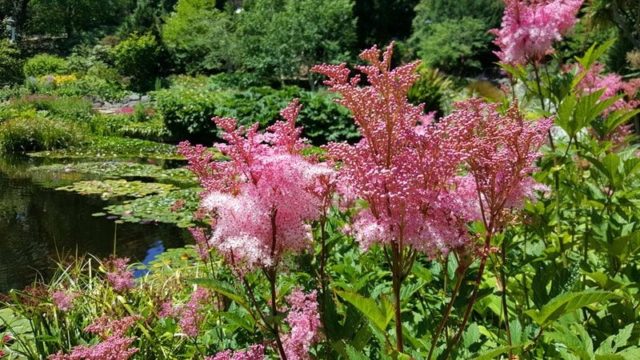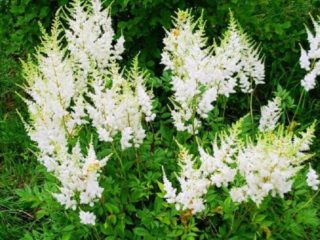Content
Meadowsweet is a native of China, distributed in eastern Russia and Mongolia. It is used as a medicinal and ornamental plant, but is often confused with other related species.
Description of meadowsweet and characteristics
There are 2 genera of plants that are often called meadowsweet: Filipendula and Spiraea. Most often, spirea is grown in gardens as an ornamental plant. But this is a deciduous shrub. Filipendula is a perennial herb.
In the reference book “Flora of the USSR”, used in 1934-1964, the name “meadowsweet” is used only for the genus Filipendula, the word “meadowsweet” is reserved for Spiraea. But in other publications of the same time, the genus Filipendula was called both meadowsweet and meadowsweet. Moreover, the terms were practically equivalent. In Dahl's explanatory dictionary, another genus is named in exactly the same way as meadowsweet and meadowsweet: Spirea.
Therefore, when figuring out what plant we are talking about, you will have to focus on an additional word: palm-shaped. In botanical taxonomy, there is only one suitable plant species: Filipendula palmata. It is this representative of the Filipendula genus that is called “meadowsweet (meadowsweet) palm-shaped.”
It is a perennial herbaceous plant with creeping stolon-shaped roots. Its age can reach 200-300 years. The height of the peduncle is 1 m. The leaves are strongly dissected, looking like splayed fingers. Edges with many teeth. The upper side is dark green and smooth. The lower one is covered with small whitish setae.
The plant has two types of foliage: the lower ones, growing from the root rosette, and the upper ones, extending from the peduncles. Basal, that is, the very first to appear from the ground, and the lower leaves are larger than the upper ones. The latter have cuttings with which they are attached to the stem.
Meadowsweet flowers appear at the top of the peduncle. These are dense panicles that are divided into many inflorescences. Each consists of 5 white flowers. There are 5 petals, 2-3 mm in size. There are about 8 panicles on each peduncle, with a total length of 25 cm. 5-8 very long stamens in each flower create the impression of a fluffy cloud on the stem.

The “life” of individual inflorescences is 20-25 days, the budding period is from mid-June to mid-June
Reproduction methods
Meadowsweet is propagated in two ways: by seeds and by dividing the rhizomes. All meadowsweet grow very slowly. It takes 9-10 years for complete development from Filipendula palmata seeds, and the rosette is formed only in the 2-3rd year of life. When propagated by rhizomes, meadowsweet blooms already in the 3rd-4th year.
Propagation by roots
In addition to the speed of growing, this method has one more advantage: it is the simplest. Meadowsweet is propagated in this way in the autumn after the plant goes into hibernation.The root is cut into pieces of 5-6 cm, making sure that each has 3-4 vegetative buds. The resulting planting material is placed in open ground to a depth of 5 cm.
Autumn planting is preferable, as the plant will survive the winter well and will receive the maximum amount of water in the spring.
Propagation by seeds
If you couldn’t get rhizomes and only seeds are available, you can try to get meadowsweet in this way. In nature, some of its seeds germinate immediately, others only the next year, after natural stratification.
When culturally propagated, gardeners prefer to carry out stratification artificially, controlling the process. Before planting, the seeds are treated with a growth stimulator. They need to be planted in very moist soil. Therefore, meadowsweet is planted as soon as the snow begins to melt. You can, of course, create a man-made “swamp”.
In the first year of life, the sprouts must be protected from the sun. Under natural conditions, at this stage, young meadowsweet is shaded by taller grass. Meadowsweet also needs very moist air. In thickets of grass, movement is very slow, and water is actively evaporating.

It is difficult to artificially create the conditions necessary for meadowsweet, so it is easier to use vegetative propagation
Growing and care
Meadowsweet is such a moisture-loving plant that in its homeland it was called “mosquito grass.” In nature, it grows in waterlogged places and near water bodies. Mosquitoes emerging from the water hide in its leaves. Hence the Chinese name.
Accordingly, when planting meadowsweet as an ornamental plant, it is necessary to choose an area saturated with water.
Meadowsweet does not require labor-intensive care during the growing season. In addition to watering, you only need to periodically loosen the soil and remove weeds. It's enough. If desired, you can make sure that the roots of the meadowsweet do not “encroach” on other areas. Otherwise, there is a risk of getting a garden completely overgrown with meadowsweet.
In autumn, the plant loses its attractive appearance. At this time, it is cut at a height of 5-10 cm from the ground. The meadowsweet does not require any more care.
Feeding
And here the meadowsweet does not require any special frills. Regular complex fertilizer 2 times a year is enough: in spring and autumn.
Pests and diseases
Meadowsweet of all types is not very good with this aspect. Among the diseases, they, including meadowsweet, are susceptible to powdery mildew, brown spot (ramularia), rust and thermal burns of inflorescences in hot weather.
Under natural conditions, meadowsweet often gets sick with powdery mildew and rust. Ramulariasis is more common in garden plots. In the meadowsweet, powdery mildew often affects the inflorescences, which is why the plant loses its decorative appearance. Rosette leaves are most susceptible to spotting.
Among the pests, meadowsweet is attacked by pipeweed, aphids, mole crickets, and wireworms.
The species composition of pests is the same for all types of meadowsweet.

Raspberry aphids can suck all the juices out of the meadowsweet before the plant blooms.
Application in landscape design
Enough time has passed since the cultivation of meadowsweet for varieties to appear. That is, a group of plants of the same species, but often very different from each other.
The palm-shaped meadowsweet has at least three varieties: low-growing (about 20 cm), medium-growing (60 cm) and tall (1 m).
The latter is the original variety of Chinese mosquito grass.

Taking advantage of the meadowsweet's love for wet places, it is often planted next to a decorative pond
You can plant meadowsweet as a separate bush or make a small curtain along the shore of a reservoir.
A low-growing variety can be planted as a border along a path, and a medium- and tall-growing variety can be used as a living fence. But in this case, you will have to water the plants often.
Also, meadowsweet is often planted in mixborders in the background or in the center of the composition. Meadowsweet harmonizes well with the following plants:
- lilies;
- ferns;
- astilbe;
- hydrangeas;
- daylilies;
- irises;
- carnations;
- peonies;
- various types of tobacco;
- clematis.
Meadowsweet has a very pleasant aroma. If desired, they can decorate the entrance to the house. But this plant is also a honey plant. That is, along with a pleasant smell, bees will also penetrate into the house.
https://www.youtube.com/watch?v=7sNCNnvHciU
Conclusion
Meadowsweet is an unpretentious ornamental honey plant that grows well in any fertile soil. But due to confusion in the names, when purchasing, it is better to focus on its Latin name “Filipendula palmata”.








